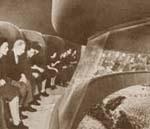 |
|
futurama, autogeddon |
|
Imagining |
ten: the ghosts of the future
[28] David Gelertner, in comparing the 1990s with the 1930s, has suggested that the difference between the optimistic futurism of the World's Fair and the pessimism of the 1990s is a lack of belief in "the future." In fact, he suggests, the utopia imagined in the 1930s was in many ways achieved, although perhaps not in the way its dreamers hoped: The fair predicted that Americans would move out of the cities into the suburbs, and we did. It claimed that the automobile would remake the landscape, and it did. It foresaw working and middle classes that were rich enough to live 'the good life,' and in the fair's terms that is exactly what we have done. (367) He goes on to suggest that ...should we ever wish to change things and return to a world view like the high thirties,' ... our biggest task will be to see something where today we see nothing; to imagine the future, period (369). What Gelertner forgets, though, is that the ghosts of that future are with us, every time we engage in the act of imagining potential futures for ourselves. The future is not a lack of imagination but an overflowing of it, so much so that voices come from it and speak to us in ways we don't expect. The ghosts of Bel Geddes' Futurama -- the ghosts of the people for whom the future never came, at least not in the way they imagined -- continue to speak to us from Ballard's stylized depictions of automobile-created death. [29] Jacques Derrida, meditating on what it means to live in a world populated with the ghosts of the dead, suggests that we owe our ghosts, both present and future, some consideration. In doing so, his implication is that responsibility lasts beyond our immediate present, and therefore we must learn to think about the future effects of our contemporary decisions: No justice ... seems possible or thinkable without the principle of some responsibility, beyond all living present, within that which disjoins the living present, before the ghosts of those who are not yet born or who are already dead... (xix). These ghosts live on in every fictional imagination of the future we engage in. Science fictional landscapes, whether Ballard's texts or Bel Geddes' dioramas, give us an unique chance to imagine what our next steps might be like. The social, environmental and economic change that we enact now will change lives in the future; so, too, will the narratives we tell ourselves about the future, just as the narratives told about the coming of the Interstate system in the thirties and fifties changed the way countless lives unfolded from the sixties to the nineties and beyond. Despite Gelertner's characterization of the present as somehow future-less, the stories we continue to weave do, in fact, contain a future. Whether these narratives are golden, as they were in the age of technological utopianism, or pessimistic, as they are in Ballard's networks of death, the ghosts of the future will come back to speak to us. |
| 1 |
| 2 |
| 3 |
| 4 |
| 5 |
| 6 |
| 7 |
| 8 |
| 9 |
| 10 << |
| credits |
| rhizomes |